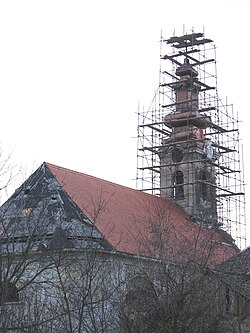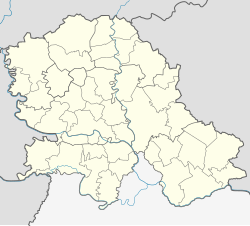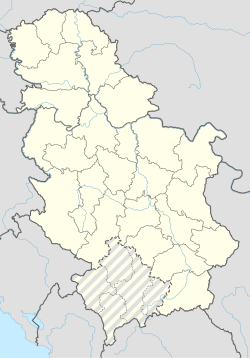Savino Selo: Difference between revisions
fixed typo Tags: Mobile edit Mobile web edit |
m Task 20: replace {lang-??} templates with {langx|??} ‹See Tfd› (Replaced 1; ignored 1: Lang-sr-Cyrl); |
||
| (20 intermediate revisions by 11 users not shown) | |||
| Line 1: | Line 1: | ||
{{Infobox settlement |
{{Infobox settlement |
||
|official_name = Savino Selo |
|official_name = Savino Selo |
||
|other_name = |
|other_name = |
||
|native_name =Савино Село |
|native_name = {{native name|sr-Cyrl|Савино Село|italics=off}} |
||
|nickname = |
|nickname = |
||
|settlement_type = Village |
|settlement_type = [[List of populated places in Serbia|Village]] ([[village#Slavic countries|Selo]]) |
||
|motto = |
|motto = |
||
|image_skyline = Savino_Selo_church.jpg |
|image_skyline = Savino_Selo_church.jpg |
||
| Line 16: | Line 16: | ||
|mapsize = |
|mapsize = |
||
|map_caption = |
|map_caption = |
||
|pushpin_map = Serbia |
|pushpin_map = Serbia Vojvodina#Serbia#Europe |
||
|pushpin_label_position =bottom |
|pushpin_label_position =bottom |
||
|pushpin_mapsize= |
|pushpin_mapsize= |
||
|pushpin_map_caption = |
|pushpin_map_caption = |
||
|subdivision_type = Country |
|subdivision_type = [[List of sovereign states|Country]] |
||
|subdivision_name ={{flag|Serbia}} |
|subdivision_name = {{flag|Serbia}} |
||
|subdivision_type1 = [[Administrative divisions of Serbia|Province]] |
|subdivision_type1 = [[Administrative divisions of Serbia|Province]] |
||
|subdivision_name1 = {{flag|Vojvodina}} |
|subdivision_name1 = {{flag|Vojvodina}} |
||
|subdivision_type2 = [[ |
|subdivision_type2 = [[List of regions of Serbia|Region]] |
||
|subdivision_name2 = |
|subdivision_name2 = [[Bačka]] ([[Podunavlje]]) |
||
|subdivision_type3 = [[ |
|subdivision_type3 = [[Districts of Serbia|District]] |
||
|subdivision_name3 = |
|subdivision_name3 = [[South Bačka District|South Bačka]] |
||
|subdivision_type4 = [[Municipalities and cities of Serbia|Municipality]] |
|||
|subdivision_name4 = [[File:Vrbas-grb.png|16px]] [[Vrbas, Serbia|Vrbas]] |
|||
|government_footnotes = |
|government_footnotes = |
||
|government_type = |
|government_type = |
||
| Line 60: | Line 62: | ||
|footnotes = |
|footnotes = |
||
}} |
}} |
||
'''Savino Selo''' ({{Lang-sr-Cyrl|Савино Село}}), formerly Torschau, is a village in [[Serbia]]. It is situated in the municipality of [[Vrbas (city)|Vrbas]], in the [[South Bačka District]], [[Vojvodina]] province. |
'''Savino Selo''' ({{Lang-sr-Cyrl|Савино Село}}; {{langx|hu|Torzsa}}), formerly Torschau / Torszà / Torša, is a village in [[Serbia]]. It is situated in the municipality of [[Vrbas (city)|Vrbas]], in the [[South Bačka District]], [[Vojvodina]] province. |
||
==History== |
==History== |
||
A settlement named Torsza was first mentioned in 1486. After the Turkish |
A settlement named Torsza was first mentioned in 1486. After the Turkish wars had ended by the late 17th century, the Bačka was widely deserted. During the reign of Emperor Josef II it was being repopulated by mostly Rhinehessian families, called Švabo ([[Danube Swabians]]) by their Serbian and Slovak neighbours. The village of Torschau (Hungarian Torszà, Serbian Torža) was built in 1784 by these German Protestant settlers, the first of seven newly founded German villages in the Batschka. 20 other German villages were restored and resettled.<ref>{{Cite web |url=https://privat.genealogy.net/flacker/josans.htm/ |title=Josefinische Siedlungen |access-date=2019-04-12 |archive-date=2019-05-09 |archive-url=https://web.archive.org/web/20190509062109/http://privat.genealogy.net/flacker/josans.htm |url-status=dead }}</ref><ref>{{cite web |url=https://www.sulinet.hu/oroksegtar/data/magyarorszagi_nemzetisegek/nemetek/die_donauschwaben/pages/008_Deutsche_Siedlungsgebiete.htm/ |title=4. Deutsche Siedlungsgebiete in Südosteuropa nach der Türkenzeit. Die Donauschwaben als »deutscher Neustamm« |website=www.sulinet.hu |url-status=dead |archive-url=https://web.archive.org/web/20140202095227/http://www.sulinet.hu/oroksegtar/data/magyarorszagi_nemzetisegek/nemetek/die_donauschwaben/pages/008_Deutsche_Siedlungsgebiete.htm |archive-date=2014-02-02}} </ref> Over the years the village became ethnically mixed; until 1944 with a mainly German plus Serbian, Slovak and Hungarian population. In 1934 a monument was erected in remembrance of the village's 150 year long history. The Reformed Protestant church has recently been reconstructed and rededicated as Serbian Orthodox. |
||
Savino Selo literally means "Sava's Village", and is today named after[[Montenegrins|Montenegrin]][[Yugoslav Partisans|Partisan]] commander and |
Savino Selo literally means "Sava's Village", and is today named after the legendary [[Montenegrins|Montenegrin]] [[Yugoslav Partisans|Partisan]] commander and [[Order of the People's Hero|war hero]] [[Sava Kovačević]]. During the last days of [[WWII]], Torschau's German population fled in front of approaching Red Army units, mainly to Hungary, Austria and Germany. In 1945, colonisation of people from Bosnia and Montenegro (especially [[Vasojević clan]]) formed the current ethnic structure of the village.<ref>{{Cite web|url=https://www.nasemesto.rs/2017/08/04/vremeplov-kolonizacija-savinog-sela-odakle-su-stigle-porodice/|title = (VREMEPLOV) Kolonizacija SAVINOG SELA - Odakle su stigle porodice|date = 4 August 2017}}</ref><ref>{{Cite web|url=http://www.novosti.rs/vesti/naslovna/reportaze/aktuelno.293.html:474966-Bermudski-trougao-u-Backoj|title = Bermudski trougao u Bačkoj}}</ref><ref>{{Cite web|url=https://www.danas.rs/drustvo/treca-generacija-gorstaka-iz-ravnice/|title=Treća generacija gorštaka iz ravnice - Društvo - Dnevni list Danas}}</ref> |
||
In 1944, during the last months of [[WWII]], Torschau's German population, threatened by partisans and approaching Red Army units, was forced to flee, mainly to Hungary, Austria and Germany. |
|||
Those who could not flee, such as old people, women and children, were interred in a camp in the village. There, they were starved, raped and otherwise mistreated. Many died as a result. <ref>http://www.swabiantrek.com/?page_id=504/</ref> The survivors were exiled during the following years.<ref>http://doku.zentrum-gegen-vertreibung.de/archiv/frameset05.htm/</ref> No restitutions were ever made. By 1947/48, Torschau's German population, about 3200 out of 3800 people, was gone. |
|||
Instead, from 1945, partisans and settlers from Bosnia and Montenegro took over the village, forming the current ethnic structure. <ref>https://www.nasemesto.rs/2017/08/04/vremeplov-kolonizacija-savinog-sela-odakle-su-stigle-porodice/</ref><ref>http://www.novosti.rs/vesti/naslovna/reportaze/aktuelno.293.html:474966-Bermudski-trougao-u-Backoj</ref><ref>https://www.danas.rs/drustvo/treca-generacija-gorstaka-iz-ravnice/</ref> |
|||
==Ethnic groups today== |
==Ethnic groups today== |
||
| Line 111: | Line 111: | ||
{{coord|45|30|N|19|31|E|region:RS_type:city|display=title}} |
{{coord|45|30|N|19|31|E|region:RS_type:city|display=title}} |
||
{{ |
{{Commons category|Savino Selo}} |
||
{{Authority control}} |
|||
[[Category:Places in Bačka]] |
[[Category:Places in Bačka]] |
||
Latest revision as of 05:44, 3 November 2024
Savino Selo
Савино Село (Serbian) | |
|---|---|
 The former Protestant Church, now Serbian Orthodox. | |
| Coordinates: 45°30′N 19°31′E / 45.500°N 19.517°E | |
| Country | |
| Province | |
| Region | Bačka (Podunavlje) |
| District | South Bačka |
| Municipality | |
| Time zone | UTC+1 (CET) |
| • Summer (DST) | UTC+2 (CEST) |
Savino Selo (Serbian Cyrillic: Савино Село; Hungarian: Torzsa), formerly Torschau / Torszà / Torša, is a village in Serbia. It is situated in the municipality of Vrbas, in the South Bačka District, Vojvodina province.
History
[edit]A settlement named Torsza was first mentioned in 1486. After the Turkish wars had ended by the late 17th century, the Bačka was widely deserted. During the reign of Emperor Josef II it was being repopulated by mostly Rhinehessian families, called Švabo (Danube Swabians) by their Serbian and Slovak neighbours. The village of Torschau (Hungarian Torszà, Serbian Torža) was built in 1784 by these German Protestant settlers, the first of seven newly founded German villages in the Batschka. 20 other German villages were restored and resettled.[1][2] Over the years the village became ethnically mixed; until 1944 with a mainly German plus Serbian, Slovak and Hungarian population. In 1934 a monument was erected in remembrance of the village's 150 year long history. The Reformed Protestant church has recently been reconstructed and rededicated as Serbian Orthodox.
Savino Selo literally means "Sava's Village", and is today named after the legendary Montenegrin Partisan commander and war hero Sava Kovačević. During the last days of WWII, Torschau's German population fled in front of approaching Red Army units, mainly to Hungary, Austria and Germany. In 1945, colonisation of people from Bosnia and Montenegro (especially Vasojević clan) formed the current ethnic structure of the village.[3][4][5]
Ethnic groups today
[edit]According to the 2002 census, ethnic groups in the village include:
- 1,280 (38.20%) Montenegrins
- 1,211 (36.14%) Serbs
- 166 (4.95%) Slovaks
- 161 (4.81%) Hungarians
- 106 (3.16%) Croats
- others.
Population after WWII
[edit]- 1961: 5,144
- 1971: 4,044
- 1981: 3,749
- 1991: 3,767
See also
[edit]References
[edit]- ^ "Josefinische Siedlungen". Archived from the original on 2019-05-09. Retrieved 2019-04-12.
- ^ "4. Deutsche Siedlungsgebiete in Südosteuropa nach der Türkenzeit. Die Donauschwaben als »deutscher Neustamm«". www.sulinet.hu. Archived from the original on 2014-02-02.
- ^ "(VREMEPLOV) Kolonizacija SAVINOG SELA - Odakle su stigle porodice". 4 August 2017.
- ^ "Bermudski trougao u Bačkoj".
- ^ "Treća generacija gorštaka iz ravnice - Društvo - Dnevni list Danas".
- Slobodan Ćurčić, Broj stanovnika Vojvodine, Novi Sad, 1996.
- de:Donauschwaben
- Danube Swabians
- http://www.swabiantrek.com/?page_id=504
Gallery
[edit]-
The Reformed Protestant Church.
-
The steeple of the Reformed Protestant church.
-
Monument in the village, commemorating German settlement.
45°30′N 19°31′E / 45.500°N 19.517°E






